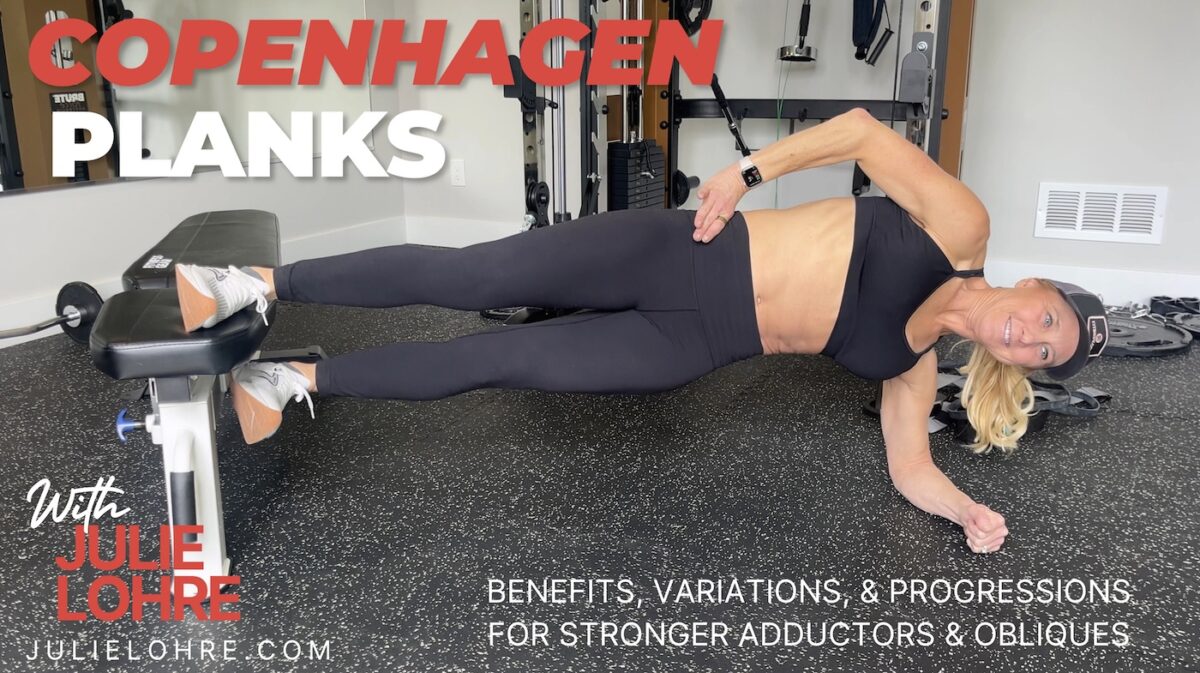Copenhagen Plank: Benefits, Variations, & Progressions for Women
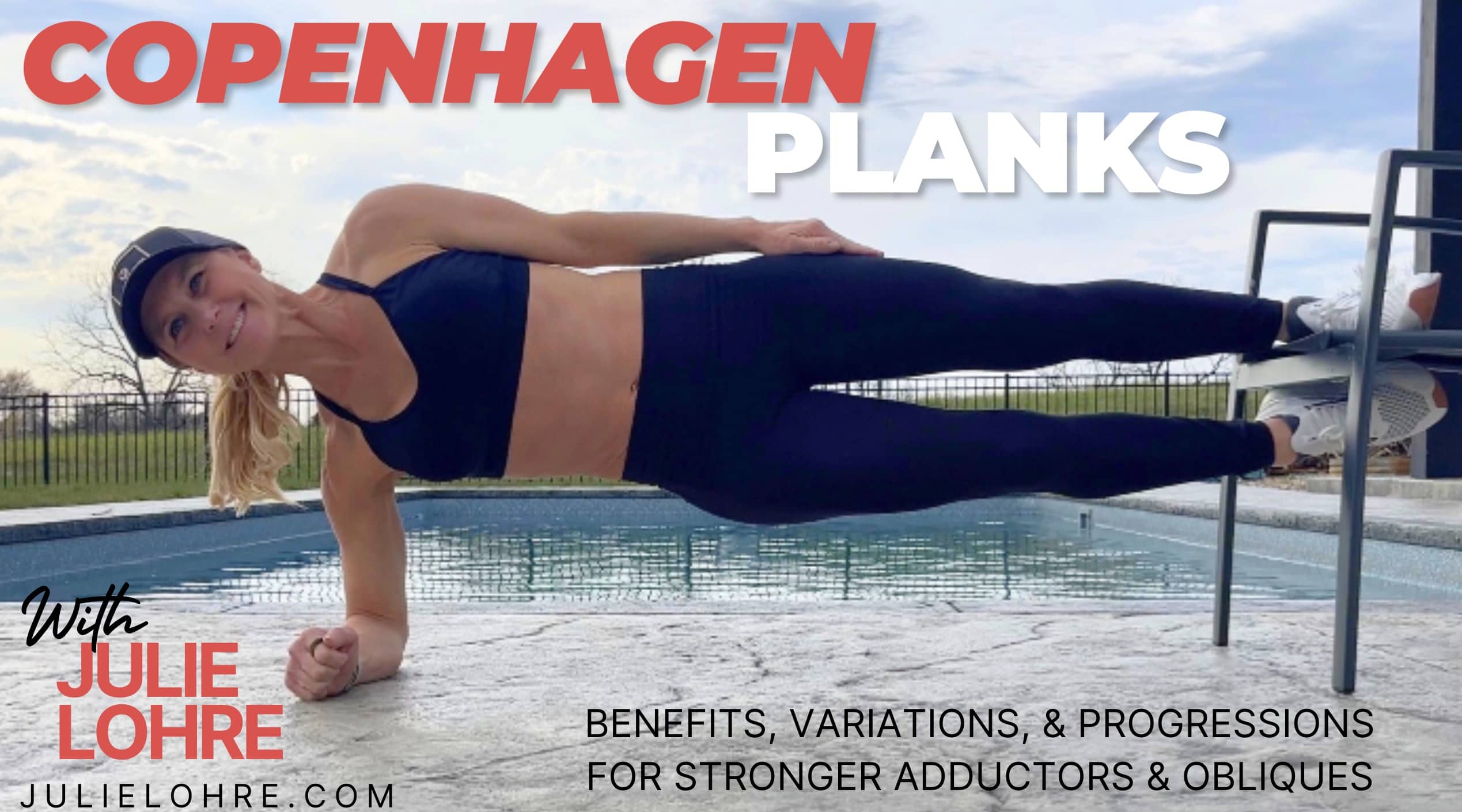
The Copenhagen plank is an innovative and challenging variation of the traditional plank exercise that targets not just the core muscles but also the adductors and the entire side of the body. This exercise has gained popularity in recent years for its ability to enhance core stability, improve balance, and strengthen the inner thighs and obliques. I frequently add this inner thigh exercise in with my online training clients that workout at home because it is an excellent way to target thighs and obliques with little to no equipment. If you are looking for a challenge, try incorporating the Copenhagen plank into your workout routine! Here’s my comprehensive guide to mastering the Copenhagen plank, detailing the exercise benefits and taking you through Copenhagen plank progressions like pulses and other variations.
Table of Contents
What is the Copenhagen Plank?
How to Perform the Copenhagen Plank
Copenhagen Plank Variations & Progressions
Copenhagen Plank Pulse
What Muscles Does the Copenhagen Plank Work?
What are the benefits of the Copenhagen Plank?
How Long Should I Hold a Copenhagen Plank?
Why is it called a Copenhagen Plank?
Scientific Research Sources
What is the Copenhagen Plank?
The Copenhagen plank is a dynamic exercise that involves a side plank with the top leg elevated on a bench or a sturdy surface, and the bottom leg suspended in the air. This position intensifies the work required from your core and inner thigh muscles to maintain stability. The exercise effectively engages the adductors (inner thigh muscles), obliques, glutes, and the entire core, providing a challenging workout that goes beyond the benefits of a standard plank.
How to Perform the Copenhagen Plank
- Start Position: Begin by placing your forearm on the ground and your upper foot on a bench or elevated surface like a chair. Ensure your shoulder is directly above your elbow for proper alignment.
- Execution: Lift your hips off the ground to form a straight line from head to heels. Your lower leg should be hanging freely or resting slightly on the ground for additional support.
- Hold: Maintain this position, keeping your core engaged and hips lifted, for 20 to 30 seconds before switching sides.
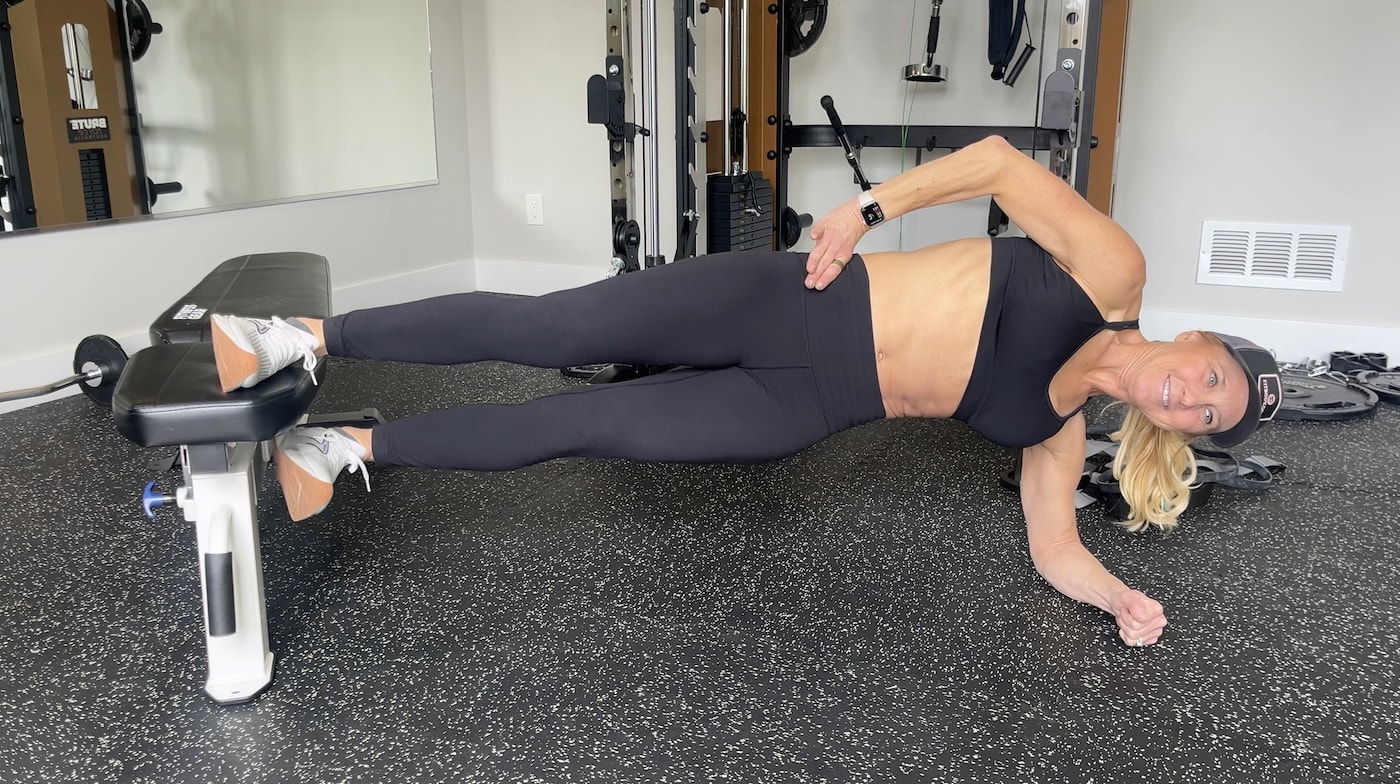
Copenhagen Plank Variations & Progressions for All Levels
Beginners: Modified Copenhagen Plank
- Supportive Touch: Place the bottom knee on the ground for extra support, reducing the load on your adductors and core.
- Shorter Hold Time: Start with shorter durations, such as 10-15 seconds, and gradually increase as you gain strength.
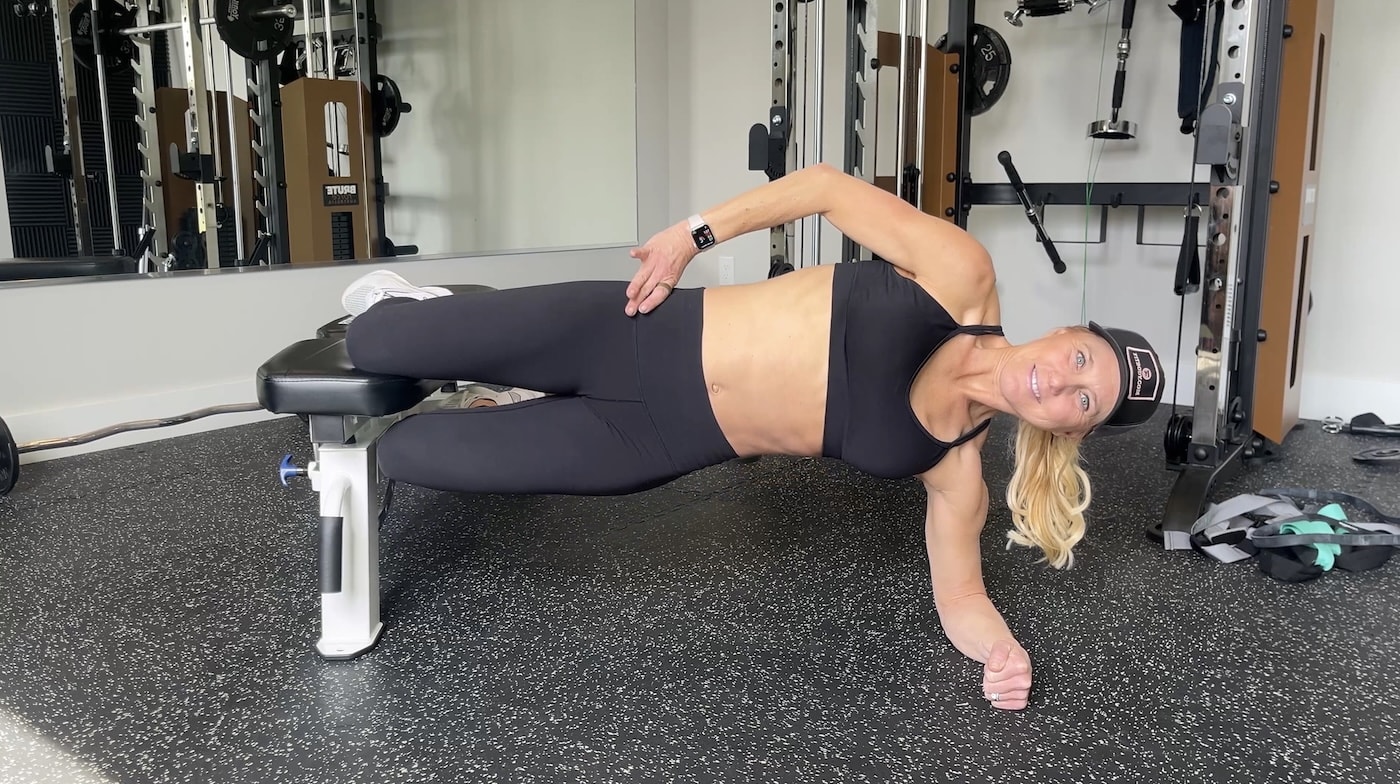
Intermediate: Standard Copenhagen Plank
- Elevated Surface: Use a higher elevation for your top leg to increase the difficulty slightly.
- Increased Hold Time: Aim for 30-45 seconds, focusing on maintaining proper form and alignment.
Advanced: Dynamic Copenhagen Plank
- Leg Lifts: While in the Copenhagen plank position, add small lifts with your lower leg to increase the intensity and adductor engagement (See Copenhagen Plank Pulses below).
- Extended Hold Time: Challenge yourself to hold the position for 45-60 seconds, ensuring your form doesn’t suffer.
Copenhagen Plank Pulse Variations
The Copenhagen Plank Pulse is a dynamic variation of the traditional Copenhagen plank that adds a pulsing movement to the exercise, intensifying the engagement of the targeted muscles and introducing a cardiovascular element. This variation not only continues to work on the strength and stability of the core and lower body but also increases the challenge to your endurance and muscle control. Here’s how to perform it and the benefits you can expect.
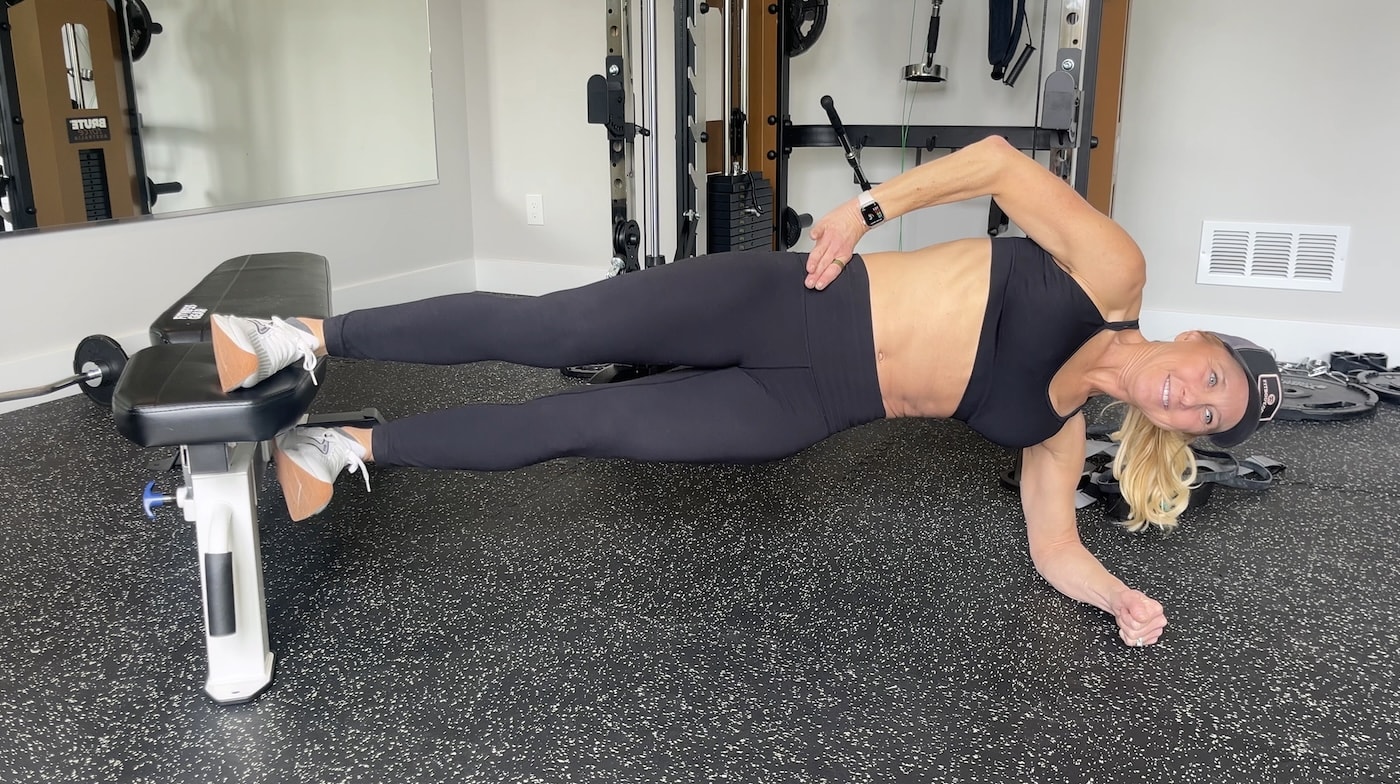
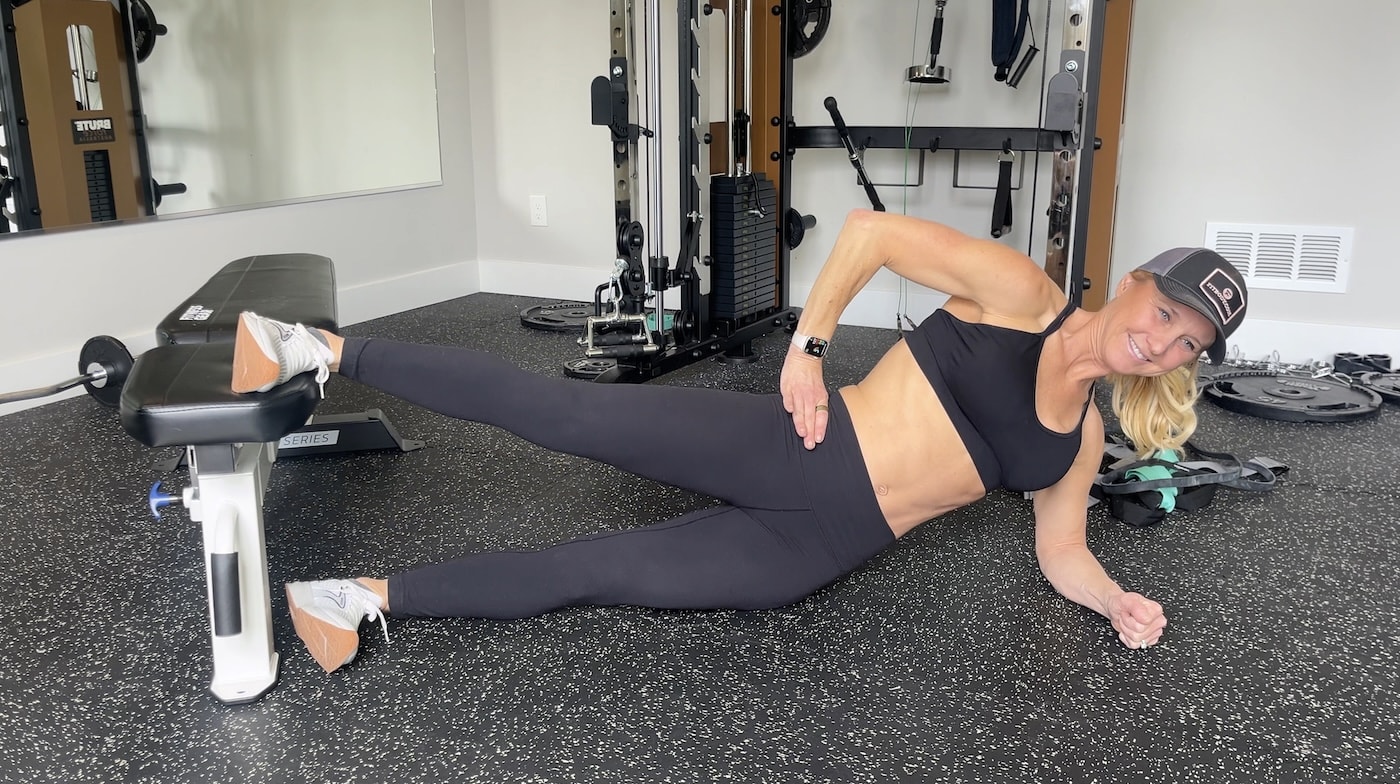
How to Perform the Copenhagen Plank Pulse
- Setup: Begin by setting up in the standard Copenhagen plank position. Place your forearm on the ground and your upper foot on a bench or elevated surface. Ensure your shoulder is directly above your elbow, and your body forms a straight line from head to heels.
- Positioning: Elevate your hips off the ground to enter the side plank position, with your lower leg hanging freely. Your upper leg (the one resting on the bench) should be straight, and your core should be engaged.
- Pulsing Movement: Once stable, initiate a small, controlled pulsing movement by slightly lifting and lowering your hips. This pulsing action should be moderate in amplitude, focusing on engaging the adductors of the upper leg and the obliques.
- Breathing: Maintain steady breathing throughout the exercise. Inhale as you lower your hips slightly, and exhale as you lift.
- Duration: Hold and pulse in this position for 20-30 seconds (or as long as can be managed without compromising form), then switch sides.
- To modify the Copenhagen plank pulse, you can do the movement with your knee bent.
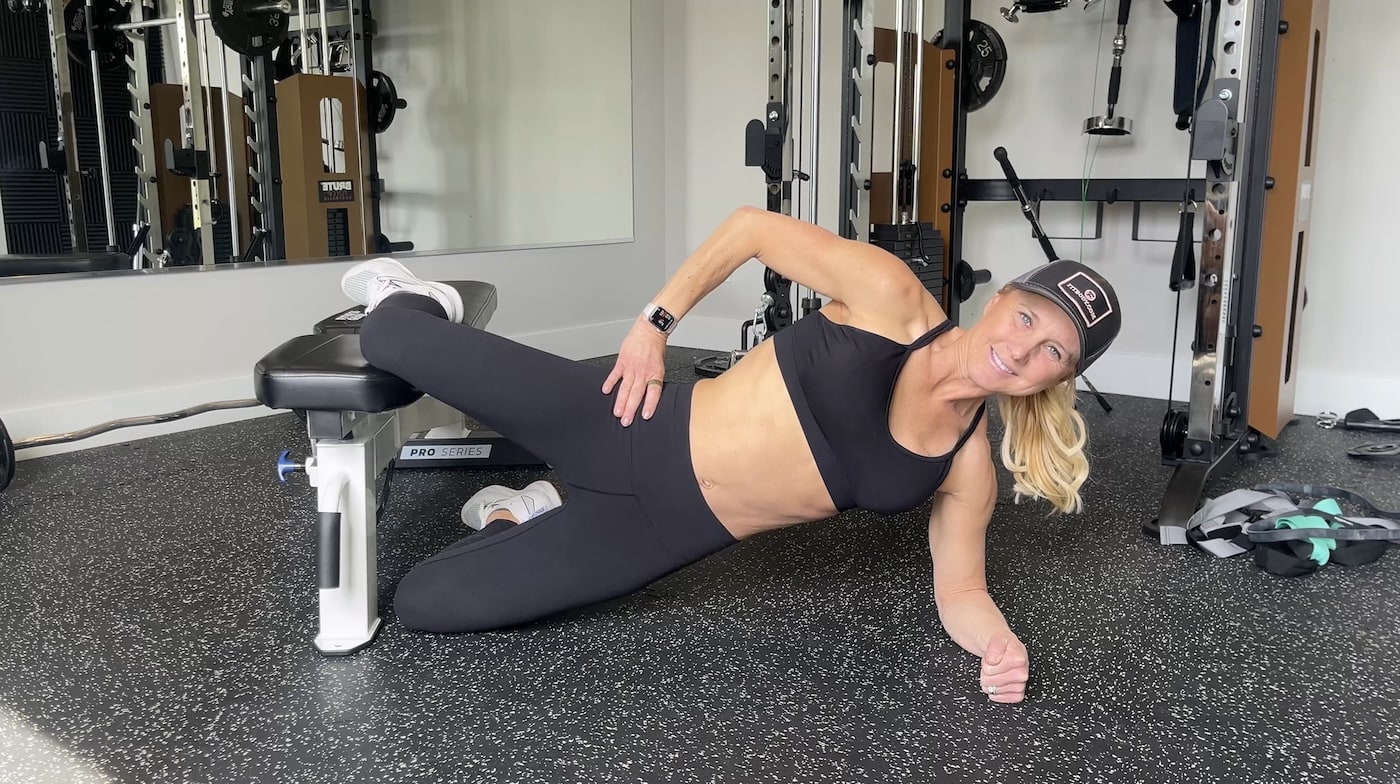

What muscles does the Copenhagen plank work?
This multifaceted exercise that targets several muscle groups simultaneously, with a particular focus on the following areas:
Primary Muscle Groups Worked with the Copenhagen Plank:
- Adductors (Inner Thigh Muscles): This includes the adductor longus, adductor brevis, adductor magnus, and gracilis. These muscles are significantly engaged as they work to stabilize the elevated leg and maintain the body in a side plank position. The adductors are responsible for pulling the legs toward the body’s midline, and in the Copenhagen plank, they are activated to support the body’s weight and stabilize the pelvis.
- Obliques (Side Abs): Both the internal and external obliques are engaged during the Copenhagen plank. These muscles wrap around the sides of the abdomen and are crucial for rotating the trunk, lateral flexion (side bending), and stabilizing the core. In the Copenhagen plank, the obliques are activated to maintain the body in a straight line and prevent the hips from sagging.
- Gluteus Medius and Minimus (Side Hip Muscles): Located on the outer aspect of the hip, these muscles are engaged to support hip stability and maintain the pelvis level during the exercise. They work alongside the adductors to keep the body elevated and stable in the side plank position.
Secondary Muscle Groups Worked with the Copenhagen Plank:
- Rectus Abdominis (Front Ab Muscles): Although the focus is on the obliques, the rectus abdominis also plays a role in stabilizing the core during the Copenhagen plank.
- Transverse Abdominis: This deep core muscle acts like a corset around the abdomen, helping to stabilize the core and spine. It’s engaged throughout the exercise to maintain stability and support the spine.
- Quadratus Lumborum: Part of the posterior abdominal wall, this muscle is engaged to help stabilize the pelvis and spine, especially during the unilateral (single-sided) challenge that the Copenhagen plank presents.
- Hip Flexors: The hip flexors, including the iliopsoas, may also be engaged, particularly in the elevated leg, to maintain the position of the leg on the bench or elevated surface.
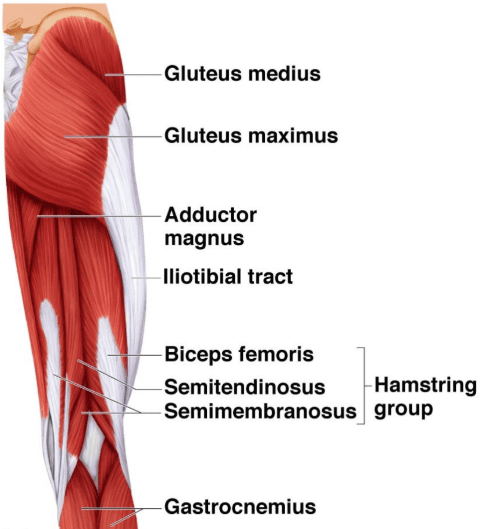
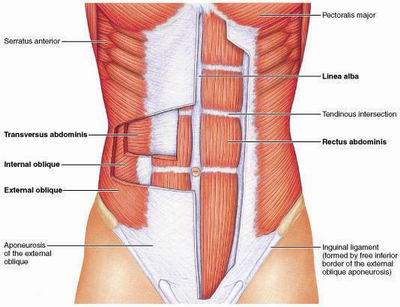
What are the benefits of the Copenhagen Plank?
I am often asked why women should include the Copenhagen plank. With its unique body position and adaptability, it brings several physical benefits. Let me shed light on why this exercise is so effective and beneficial, especially for women.

Strengthens the Adductors
The adductors, or inner thigh muscles, play a crucial role in lower body strength and stability. They are responsible for pulling the legs toward the midline of the body, an action known as adduction. During the Copenhagen plank, the weight of the elevated leg places a significant load on the adductors of the supporting leg. This load requires the muscles to contract isometrically (without changing length) to maintain the position. Over time, this leads to increased muscle strength and hypertrophy (growth) in the adductor group. Strong adductors are essential for a variety of movements, including walking, running, and squatting, and they help stabilize the pelvis, reducing the risk of injuries in the lower back and knees.
Enhances Core Stability
Core stability refers to the ability of the muscles of the torso to support the spine and pelvis under static and dynamic conditions. The Copenhagen plank targets not only the superficial muscles, such as the rectus abdominis and obliques, but also the deeper core muscles, including the transverse abdominis and multifidus. These muscles work together to maintain spinal alignment and prevent unnecessary movement during the exercise. Strengthening these muscles contributes to a “corset effect,” offering better support for the entire body and reducing the risk of lower back pain. Enhanced core stability is crucial for improving performance in athletic activities, maintaining good posture, and performing daily tasks more efficiently.
Improves Balance and Coordination
Balance and coordination are key components of functional fitness. The Copenhagen plank challenges these components by placing the body in an unstable, unilateral position. This requires continuous, minute adjustments from various muscle groups to maintain the pose, thereby enhancing proprioception (the sense of body position) and neuromuscular coordination. Improved balance and coordination lead to better body control and agility, making everyday activities easier and reducing the risk of falls. Additionally, exercises that challenge balance stimulate the cerebellum, a part of the brain responsible for coordinating voluntary movements, which can have positive effects on cognitive functions.
Versatile
One of the most significant benefits of the Copenhagen plank is its versatility. The exercise can be easily modified to suit different fitness levels, making it accessible to beginners while still offering a challenge to more advanced exercisers. This versatility is largely due to the ability to adjust the elevation of the supporting surface, the duration of the hold, and the intensity of the leg lift. Such modifications allow for a progressive overload, which is the gradual increase of stress placed upon the body during exercise training. This principle is fundamental for continuous improvement in physical fitness. The Copenhagen plank’s adaptability ensures that individuals can progressively increase the exercise’s difficulty as their strength and endurance improve, leading to long-term engagement and consistent physiological adaptations.
Incorporating the Copenhagen Plank into Your Routine
To get the most out of the Copenhagen plank, include it 2-3 times per week in your core or full-body workout sessions. Begin with the variation that best suits your current fitness level, and progressively challenge yourself by moving to more advanced versions or increasing the hold time as your strength improves.

How Long Should I Hold a Copenhagen Plank?
The duration for holding a Copenhagen plank can vary based on your fitness level, experience with the exercise, and specific training goals. As a general guideline, here are some recommendations for different fitness levels:
Beginners
- Start with shorter durations to ensure proper form and avoid strain. A good starting point can be 10-15 seconds per side.
- Focus on technique over duration to maximize the benefits of the exercise without risking injury.
Intermediate
- Aim for 20-30 seconds per side, as your strength and stability improve.
- Gradually increase the hold time as you become more comfortable with the exercise, ensuring you maintain proper form throughout.
Advanced
- Challenge yourself with longer durations, aiming for 30-45 seconds or even up to 60 seconds per side, depending on your ability to maintain good form.
- Consider adding variations to increase the intensity, such as the Copenhagen plank pulse, once you can comfortably hold the plank for longer periods.
General Considerations
- Quality over quantity: It’s crucial to prioritize the quality of your form over the length of time you hold the plank. Holding the plank with poor form can lead to strain and potentially cause injury.
- Listen to your body: Pay attention to what your body is telling you. If you start to lose form or feel excessive strain, it’s time to rest. Gradually increasing your hold time as you build strength is more beneficial than pushing too hard too soon.
- Consistency is key: Regular practice will help improve your endurance and ability to hold the plank for longer periods. Incorporating the Copenhagen plank 2-3 times a week into your workout routine can lead to noticeable improvements.
By adjusting the duration based on your current fitness level and focusing on maintaining proper form, you can effectively incorporate the Copenhagen plank into your training regimen for optimal benefits.
Safety Tips and Considerations
- Warm-Up: Always perform a thorough warm-up to prepare your muscles and prevent injury.
- Alignment: Pay close attention to your body alignment, keeping your hips lifted and your body in a straight line.
- Progress Gradually: Avoid jumping to advanced variations too quickly. Progress gradually to ensure you build the necessary strength and stability.
Why is it called a Copenhagen Plank?
The Copenhagen plank is named after the city of Copenhagen in Denmark, where it is believed to have gained popularity, especially among the athletic and rehabilitation communities. The exercise was popularized by its use in research and training programs aimed at soccer players, initially conducted by researchers in Copenhagen. These studies and training programs were designed to investigate and improve athletes’ performance and reduce the risk of injuries, particularly focusing on the adductors and the core, which are crucial for soccer players.
The Copenhagen plank was found to be effective in strengthening the adductors and improving core stability, which are essential for movements performed in soccer and many other sports. Given the positive outcomes from these initial applications and the research backing its effectiveness, the exercise quickly spread beyond soccer, becoming a popular tool in sports science, rehabilitation, and fitness worldwide.
The name “Copenhagen Plank” thus not only denotes its place of popularization but also reflects its roots in scientific research and athletic training, emphasizing its effectiveness in enhancing physical health and performance.
Scientific Research Sources | Appendix
Polglass, George, et al. “Impact of a Modified Progressive Copenhagen Adduction Exercise Programme on Hip Adduction Strength and Postexercise Muscle Soreness in Professional Footballers.” BMJ Open Sport & Exercise Medicine, vol. 5, no. 1, Oct. 2019, p. e000570, bmjopensem.bmj.com/content/5/1/e000570, https://doi.org/10.1136/bmjsem-2019-000570.
Schaber, Morgan, et al. “The Neuromuscular Effects of the Copenhagen Adductor Exercise: A Systematic Review.” International Journal of Sports Physical Therapy, vol. 16, no. 5, 1 Oct. 2021, https://doi.org/10.26603/001c.27975.
Langhout, Rob, et al. “Hip and Groin Injury Is the Most Common Non-Time-Loss Injury in Female Amateur Football.” Knee Surgery, Sports Traumatology, Arthroscopy, vol. 27, no. 10, 2 June 2018, pp. 3133–3141, https://doi.org/10.1007/s00167-018-4996-1.


